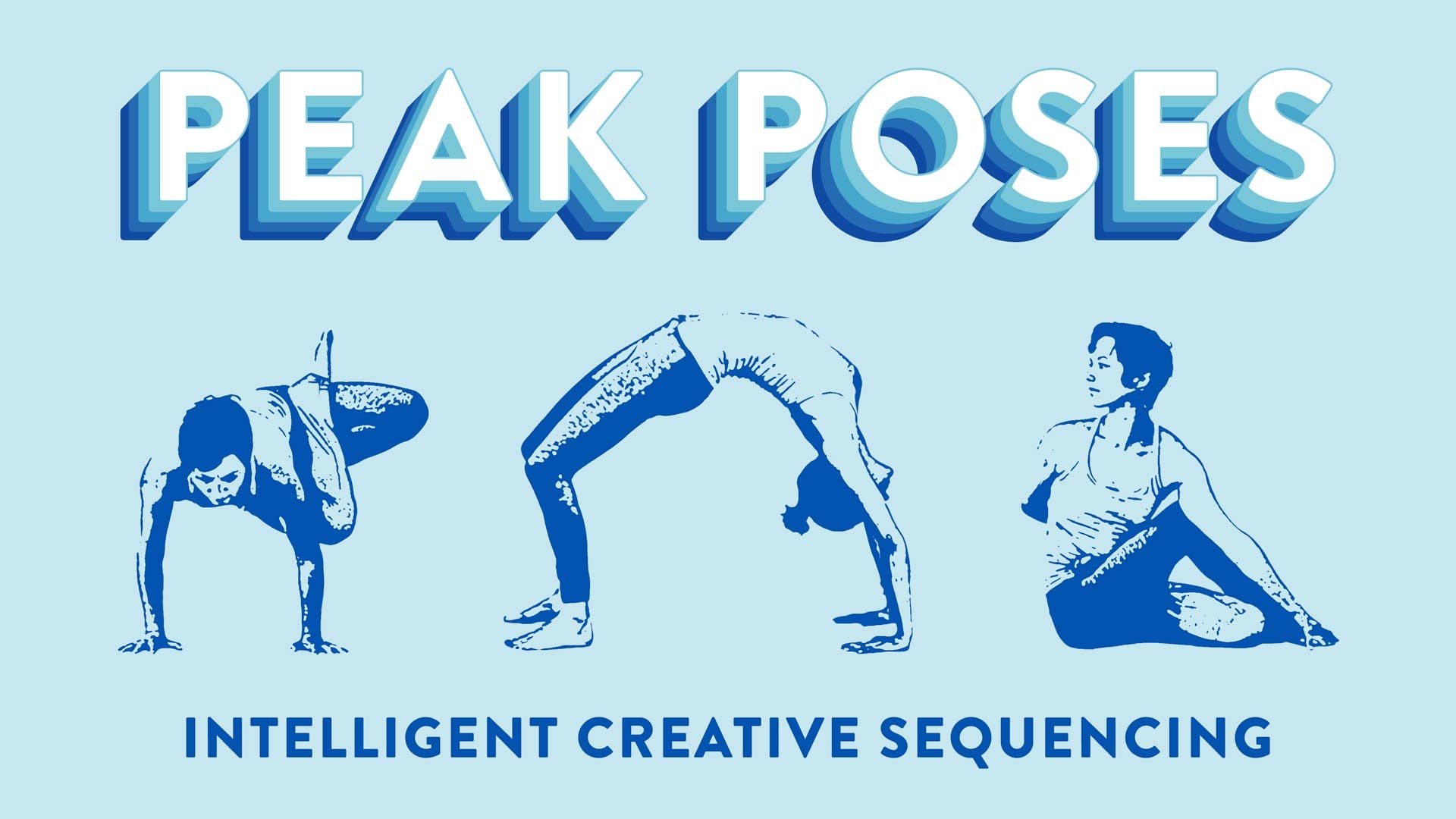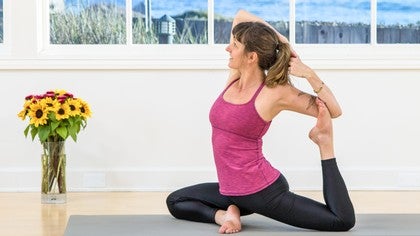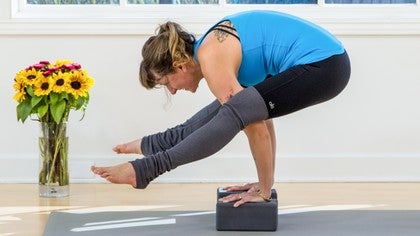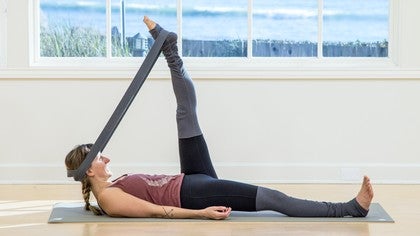Description
About This Video
Transcript
Read Full Transcript
Hi, everyone. Welcome to your practice. And this practice, we're heading towards sort of an unusual peak pose. We're going to be heading towards Shavasana, or the English translation is actually corpse pose. And I was doing some reading this morning in Light on Yoga. And Mr. Iyengar says, I never actually had read his little intro towards Shavasana. It's the very last page in the book. But he says that we're relaxing the body. And we're trying to still the mind in order to practice relaxation, to actually practice relaxation. And I don't know about you. I can be pretty type A in my practice. And if it doesn't involve 75 Chaturangas and some handstands and some other things, I might not want to do it. But as I've become older and more practice, I found that Shavasana is actually the hardest pose and one of the most important poses. And this sequence that we're going to do together today is sort of like the one, two, three for me. It's like one, two, three, and you're out and you can lay down and be still. It's very, very effective for letting the mind start to rest so that we might allow the body to relax. So let's begin on our backs. Come on down. And you're going to need a strap, a block, two blocks, and a blanket. And we're going to start with the strap. So have it nearby. But before we do anything, simply let your body rest on the floor. This is our Shavasana preview. So we're having an opportunity to feel what it feels like to just lay down without doing the practice. And then when we get to the final pose later, possibly you can feel that difference of when we consciously and intentionally work to wind down what is possible. So just allowing yourself quietly the next four or five breaths to begin to tune in. Gently open your eyes if they closed. And then reach for your strap. And you're going to make a big, huge loop out of it. So you want it to be about this size for those of you who have longer legs, a little bit longer. And we're going to take the strap around the base of our skull right where your spine goes up into your head, basically. And then you're going to bend your knee and place the strap around the base of the heel. So right where the heel becomes the arch, but not quite yet the arch. And then you're going to let the strap rest on the back of your skull as the leg comes up into the sky. Trying to untwist it here. There we go. And you're simply going to lie back, letting the legs stretch. And it takes a second to be able to get this in the exact right position. But once it's there, you find this really beautiful balance between letting the back of the neck release, the back of the skull release, which I find to be essential for having a good shavasana, and getting just a gentle opening of the back of the leg, the connective tissue at the back of the leg. And we'll stay here for a couple of minutes, actually. Just quietly. If you have the loop part of your strap where the buckle is at your side, you can always adjust it as your leg begins to open. But do make the back of the knee joint straight. We do a lot of sitting in our culture and driving and content watching. And so it's really important for our knee health to be able to open up the back of the knee joint and make space there. And then it's just a gentle reaching out through the inner thigh on that left leg. And a gentle release of the inner thigh on that right leg sometimes can bring the leg closer to you with that softening. But this is a practice not of over-efforting but of doing less. With your inhales, finding any place where you're holding on or gripping.
And with your exhales, seeing if you can let that go. If you need to hold on, you can do it later. But for this practice, let there be a real sense of softening. Letting your head fully release into the strap knowing that you are held. You don't get an opportunity to hold ourselves this way very often. And so it's a really good practice of self-trust to be able to soften into the shape. Good. And then you're going to keep the strap on your head. Take your hands to either side of the strap. Bend the right knee. Extend the right leg. And then simply take the left leg up. Place the strap around the base of the heel so it's not the arch quite yet. It's just the very beginning of the arch. And then it's the same process. Letting the head rest back, really opening up the back of the knee joint. I have a teacher in my hometown who says I will get my protractor out and measure the back of all of your knee joints. And then a student said that'd take a long time, Todd. And he said it would be worth it. And it is worth it for our knee health to really take the time to let that happen. So adjust your strap as necessary. Gently reach out through the inner thigh on that right leg. Don't worry if it's still a little externally rotated. That's fine for this practice. And then soften the inner left thigh. And sometimes with that softening, the head can rest back a little bit more and the leg might come closer to your face. What struck me about that passage in Light on Yoga was not so much that the Shavasana or corpse poses the last pose of the book. That makes sense. But that he was highlighting the practice of relaxation. That in our modern day society, that that's something that we actually need to tend to. We do enough practice of hurrying around and rushing and being in fight, flight, or freeze mode. And not enough practicing of relaxing and letting our parasympathetic nervous system take over. So that we can rest and digest and move our attention from our lizard brain into our frontal lobe through Shavasana pep talk. Really surrendering the weight of your head back into the strap.
Softening your left hip crease. The breath is just natural and steady for this practice. Ujjayi is awesome. It's sort of a victorious, triumphant breath. But it's also heating and drying. And so being aware when you're practicing Ujjayi that that's what it's doing and this is not that practice. For some of us it's hard to let go of and so that becomes a practice in and of itself. Gently take your hands to either side of the strap. Bend into your left knee. Take the strap carefully of your head, being careful not to bonk yourself with the buckle and set the strap neatly to the side. And then bring the soles of your feet together. We're going to come to Baddha Kanasana, the reclined variation. But you're going to actually lift the soles of your feet up off the floor and take your outer ankles or your outer pinky toe edges of your feet. And what we're looking for here together is from the center of your pelvis to reach out through the inner thigh bones all the way to the knee. So there's just a gentle reaching out, opening up through the groins. And you can experiment. Bring the legs closer, see what that feels like. Bring them farther away, see what that feels like. And then find a good place where you really are getting that external rotation and lengthening of the inner thigh bone all the way out beyond the knee. Just take one more big breath here, inhaling. And as you exhale, draw the knees towards one another. Cut your hands back behind your hamstrings and just rock up towards seated. And have a blanket and your blocks nearby. If you like to sit on a blanket for Uptavishta Konasana, then you might sit yourself up right now in the way that you can kind of know whether to sit on a blanket or not is if your pubic bone is way out in front of your hip points like this and you feel a sagging in your low back. And so if that's the case, then go ahead and you can even sit on a block and it feels really nice. And you're going to take a twist. So you're going to inhale your arms up into the sky, balancing the weight on your heel joints. And then exhale, turn over towards your left leg and frame your left leg with your hands. We're not going for our deepest forward fold here. What we're going for is a gentle change of the connective tissue. So reaching out through the inner thighs like you just did in your Supta Baddha Konasana, gently start to fold over your leg until you feel just that very beginning of connective tissue change in the hamstrings, but also on the right side of your body. Kind of like muffin top area or side pants. And your right sitting bone can get light. That's totally fine here. And then release from the top of your right pelvis out through the head and there might be a little bit more space. Staying really connected to our felt sense here. So as not to go too far. And really start to come up. Turning over towards your right leg. Twisting. And then framing your leg. And then again slowly starting to come in just until you feel that edge of connective tissue change.
Gaze is parallel towards the floor right now. And then release. Let the left sitting bone get light and release from the top of your left pelvis, the softening towards the left shoulder. Be in charge of your legs so that they're not letting the knees point in or out depending upon our anatomical circumstances. Not over efforting. Really approaching the forward bends in a sane manner. And then start to rise back up. Check your feet. Make sure that the weight is centered on the heel joints. And then we're either going to bring hands back behind us and stay here with the chest lifted. Many of us will stay there for a long time. But if you have the space, you'll start to fold forward between your thighs. And your head can rest on a block or on your hands depending on what kind of space you have today. Bring the breath all the way down to the back of the pelvis. Gently pressing the balls of the feet forward. Staying right on the edge of connective tissue change and softening into it as you breathe. Use your hands. Gently start to come to sit up. Really going slow and intentional here. And then bring your legs back towards one another. And we're going to take a block. And we're going to sit up on the block on the wide setting so that both of our sitting bones are on the block. And take your left foot back behind you. Take your right foot, cross it up and over your left leg so you're in a lifted Ardhamatsandrasana or seated twist shape. And the whole sole of your right foot is on the floor. And then you can grab your other block and place it right back behind your seat so that you have something for your right hand to rest on. And you'll inhale, lift your left arm up into the sky and exhale twist catching the elbow. And for this practice, instead of making it the habitual every shape is a back bend kind of shape, at least in my body, you're gently going to let your gaze move towards the floor. And your left shoulder can tip forward as your right shoulder rests back slightly. If you have long monkey arms like me, you might bring your hand to the floor rather than to the block. Nice come back up. And we're going to switch sides. So you'll undo your right leg, take the right foot, tuck it back behind you so it's next to the block toes pointing kind of at an angle back to the side. And then your left leg will cross over adjust so both of your sitting bones are on the block. Left hand comes back behind, right arm lifts up to the sky inhaling. And then exhale twisting. And again, not going into the habitual heart opening that we often see in this shape. But go ahead and let the gaze rest down and the energy of the heart move down towards the floor. Right shoulder can move a little bit forward as the left shoulder draws back bringing the twist into the whole spine, even the upper back. Keep the whole sole of the left foot on the floor as best you can. And then come on up, release back forward and set the block that was back behind you in front of you. And then take your blanket and place the blanket over the block so that you've got a nice soft block. We've basically made a homemade bolster here.
And then you're going to still use the block that you're seated on. You're going to tuck your right foot back behind and then cross your left leg up and over coming to Gomukhasana shape. And then you'll sit back down on the block, but rest your knees on this awesome tower you've made here with your blanket and your block. And then you're going to fold forward. So it's very supportive. Again, seeing that releasing of the head away from the spine the softening of the heart towards the thighs and just resting here. There's no need to come all the way down. You can just again wait for that connective tissue change to happen and pause there as something shifts. Maybe you move forward or you back up out of it. The practice is to be attentive and connective to our felt sense, to our embodied experience. And start to come on back up and we'll switch sides. So go ahead and untangle your top leg and then take the top leg and snuggle it to the side of the block. And I have to lean forward quite a bit to be able to get my knees stacked and my sitting bones on the block. And then it's the same thing you go ahead and fold on in. Remembering that each hip feels differently. It's totally okay. I didn't put my knee on the block. It's totally okay. If your sitting bones get a little bit light on the block back behind you for this practice use your hands. Push yourself back up to seated. Okay, we're gonna do one more of those. What you're gonna do is either leave the whole setup if you enjoyed that as we had it or go ahead and unwind. Carefully take your blanket and set it to the side. And you can either leave the block for your seat or take everything away and just come down onto your seat which is what I'm going to do right now. So again, we'll lean forward taking the left leg up and over the right, separating the feet and then coming back down. Notice if your brain is starting to turn off and how awesome that is. And then commit to doing one more nice long hold and then we'll come down for our Shavasana. That's the game plan. So go ahead and come in. Head releases away from the spine. Eyes might close.
Good. Good. Good. Good. Good.
Good. Use your hands to push yourself back up. And this time if you've removed the blocks out in front, go ahead and stretch the legs out for Dandasana for a moment. And let the heels shift over towards the right. Come forward. And this time your right leg is gonna swing over the top of your left. Separate the feet back behind you and sit down. And then go ahead and fold on in. Last one. It's worth it. Good. Good.
Come on back up. Unwind. Stretch your legs out in front of you. As you go into Shavasana, if you have a blanket nearby, you can grab it. And I actually like to unfold it first and then roll the fringe in into a nice tight tube. And then place the blanket underneath your knees. Avoid the urge to do any standing up. So if it's not nearby, don't grab it. And then you can come down onto your backs. If you have a second blanket, you can also place a blanket under your head to cushion your brain. Who doesn't need that? And then we rest. Letting the attention become unfocused. Letting go of any expectations around what Shavasana should be like. Letting all that arises be welcome. And then drift away. Good.
Thank you. Thank you. Thank you. Thank you. Thank you.
Thank you. Thank you. Thank you. Thank you. Thank you.
Thank you. Thank you. Thank you. I'm beginning to tune your senses back in. Let the gaze be soft or the eyes stay closed if they're closed.
Let one hand rest on your heart and one hand rest on your belly. Checking back and noticing if there was any difference between that Shavasana preview that we did in the very beginning of class and the one that you just took. If through the practices of yoga, asana, the shapes, you were able perhaps to let the mind settle and the body relax and be still. As you're ready on the exhale, rolling over to your side, cradling your head and your hands. Without a lot of extra movement, use your hands on the floor to gradually push yourself up towards seated and bring your hands to your heart.
Bowing your head in for a moment. Bowing down to that seat of expansive love that resides within each of your hearts. Namaste.
Peak Poses: Audra Carmine
Comments

You need to be a subscriber to post a comment.
Please Log In or Create an Account to start your free trial.







